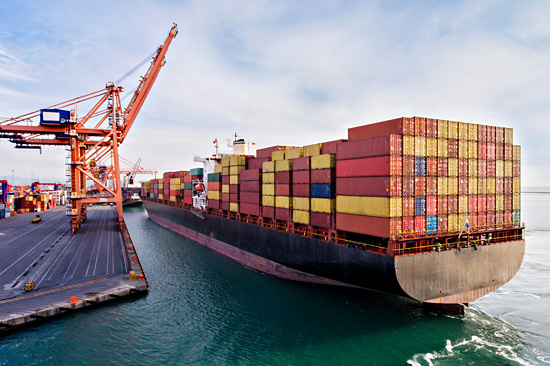Is There an End in Sight for Supply Chain Shortages?
By Gino Carollo | November 18, 2021Global supply chain shortages are causing major hiccups for businesses and consumers alike. Inventory is low, shipping times (and costs) are high, and inflation appears to be on a steady incline. You’re likely feeling the effects firsthand at places like the grocery store and gas pump. Household budgets are being stretched, and many families are having a tough time finding basic staples that used to be commonplace.
Experts say that the contributing factors behind the supply jam appear to be peaking now, which is certainly encouraging. The problem is that supply issues will likely last well into 2022.

In the meantime, supply gridlock is fueling inflation and hitting everyday folks in a very real way. Let’s untangle supply chain shortages so you can better understand how it could impact your financial life.
What’s Causing the Supply Chain Shortage?
A number of interconnected factors are at play here. The global supply chain was already strained prior to the pandemic, but the crisis acted as a tipping point. Here’s a high-level view of what’s crippling the supply chain.
- Manufacturing issues: The pandemic left many factories understaffed or dealing with temporary closures. Southeast Asia was hit particularly hard as this region is a global manufacturing hub. It effectively strangled inventory on the back end. The good news is that vaccination rates are on the rise and factories are reopening again.
- A global shortage of shipping containers: This has been a major issue—manufacturers can’t export products if they’re unable to load them into container ships. So where did they all go? Part of the problem can be traced back to the beginning of the pandemic, when massive amounts of PPE were unloaded in areas across Southeast Asia and Africa; places that then struggled to return shipping containers. This triggered a worldwide shortage that has caused shipping costs to skyrocket.
- Labor shortages: When shipping containers do arrive at U.S. shores, workers are needed to unload cargo and deliver the products to retailers and consumers. Labor shortages have severely stalled this process. By now, you’ve likely seen nightly news reports showing incoming cargo ships sitting idle for days at ports like Los Angeles and Savannah. The labor force participation rate currently sits at 61.6%; down from 63.3% before the pandemic.
How the Supply Chain Shortage Is Affecting Consumers
The most noticeable problem is limited inventory, especially as we head into the holiday gift-giving season. Toys, electronics, apparel, food and décor may all be harder to come by this year. Starting your holiday shopping early might help increase your delivery window so you aren’t left scrambling.
Beyond that, low supply—which increases demand—is also stoking inflation. This, in turn, is putting even more strain on an already weakened supply chain. Inflation has been a looming concern during the pandemic. The Federal Reserve’s target rate of inflation is 2%, but the annual rate for the past 12 months is currently 5.4%. It’s something that has a direct impact on your purchasing power. Jerome Powell, chair of the Federal Reserve, said in a recent statement that supply chain shortages will likely persist into 2022, sustaining elevated inflation.
One potential solution could be bumping up interest rates. This increases the cost of borrowing, effectively capping the circulation of money. In theory, demand (and inflation) would decrease as a result. There’s talk that interest rate hikes are expected by the end of next year.
What Supply Chain Shortages Mean for Your Finances
A direct result of inflation is that your dollar will go further today than it will in the future. It’s an important consideration for folks who are either approaching retirement or are already retired. Your spending expectations are a key part of crafting a comfortable retirement. Taking on more risk in your investment portfolio is often the recommended antidote to inflation as it can help you keep up with rising prices. In practice, this can mean holding securities like stocks, non-US securities, precious and industrial metals, and sectors that may benefit from rising rates such as financials.
If retirement is a long way off, you might also focus more on non-dollar investments like commodity investing and other alternative investments that look beyond public companies. This all underscores the importance of having a diverse portfolio. Those who were overly invested in consumer staples, for example, might be feeling the sting of the supply chain shortage more than investors who spread out their risk across different sectors.
In truth, we have virtually no control over supply chain issues—but we do have control over how we respond to it. Inflation is to be expected now and in the foreseeable future until things smooth out. In the meantime, an experienced financial advisor can help you minimize the effects of inflation, no matter what your unique financial situation looks like. Contact an Opal advisor today to get the personalized advice you need.
Be a Smart Investor
Stay up-to-date with industry-leading information and news delivered straight to your inbox.
Get our timely insights delivered to your inbox (Blog)
Please remember that past performance may not be indicative of future results. Different types of investments involve varying degrees of risk, and there can be no assurance that the future performance of any specific investment, investment strategy, or product (including the investments and/or investment strategies recommended or undertaken by Opal Wealth Advisors, LLC [“OWA]), or any non-investment related content, made reference to directly or indirectly in this commentary will be profitable, equal any corresponding indicated historical performance level(s), be suitable for your portfolio or individual situation, or prove successful. Due to various factors, including changing market conditions and/or applicable laws, the content may no longer be reflective of current opinions or positions. Moreover, you should not assume that any discussion or information contained in this commentary serves as the receipt of, or as a substitute for, personalized investment advice from OWA. OWA is neither a law firm, nor a certified public accounting firm, and no portion of the commentary content should be construed as legal or accounting advice. A copy of the OWA’s current written disclosure Brochure discussing our advisory services and fees continues to remain available upon request or at www.opalwealthadvisors.com. Please Remember: If you are a OWA client, please contact OWA, in writing, if there are any changes in your personal/financial situation or investment objectives for the purpose of reviewing/evaluating/revising our previous recommendations and/or services, or if you would like to impose, add, or to modify any reasonable restrictions to our investment advisory services. Unless, and until, you notify us, in writing, to the contrary, we shall continue to provide services as we do currently. Please Also Remember to advise us if you have not been receiving account statements (at least quarterly) from the account custodian.



